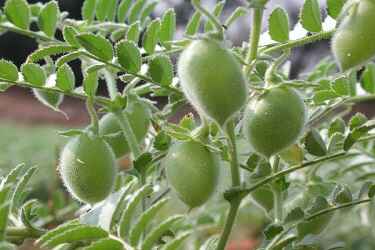Increase production of gram crop with improved technology

Introduction
India produces about 75% of the world's total chickpea crop. It is widely cultivated in Punjab, Haryana, Uttar Pradesh, Madhya Pradesh, Maharashtra, Rajasthan, Andhra Pradesh, West Bengal, and Karnataka. In Maharashtra, it is mainly grown in Vidarbha and Marathwada. Chickpeas can be eaten raw before they mature, and their tender leaves can be used as a vegetable. The root nodules of chickpeas enhance soil nitrogen content. Chickpeas, being high in protein, are used as fodder for horses and other animals. The protein content in chickpeas with husks is 16-19%, and in split beans, it is 22-25%. The tender leaves contain malic and oxalic acids. To maximize chickpea production, it is essential to use high-yielding and disease-resistant varieties, select appropriate soil, sow at the right time and at proper spacing, treat seeds, manage irrigation and crop protection effectively, and ensure balanced use of fertilizers and timely weeding.
Key Points for Increasing Production
To achieve a high yield of chickpea crops, follow these practices:
- Use high-yielding and disease-resistant varieties.
- Select and prepare appropriate soil.
- Sow at the right time and maintain proper spacing.
- Treat seeds and use bio-fertilizers.
- Perform timely weeding.
- Manage irrigation properly.
- Protect the crop from pests and diseases.
- Use sprinkler irrigation and proper water management.
Soil and Climate
Chickpea requires medium to heavy soil (45 to 60 cm deep) with good drainage, fertility, and friability. Areas with annual rainfall of 700 to 1000 mm are suitable. Chickpeas thrive in cold and dry climates with adequate sunlight and moisture. The crop grows well in soil with a pH of 5.5 to 8.6. Avoid light, swampy, and saline soils.
Pre-Sowing Preparation
After harvesting the Kharif crop, plow the soil deeply (25 cm) and then plow twice with a harrow. Clear the field of debris and prepare it for sowing by the end of September.
Sowing Time
For dry farming, sow chickpeas when there is enough moisture in the soil, usually by the end of September or by October 10. In irrigated areas, sow between October 20 and November 10. Sow seeds at a depth of 10 cm in dry areas and 5 cm in irrigated areas.
High-Yielding Varieties
- Vijay: High-yielding, root disease-resistant, suitable for both dry and irrigated areas. Matures in 105-110 days with an average yield of 20-25 quintals/hectare in irrigated areas.
- Digvijay: Suitable for both dry and irrigated areas, matures in 90-95 days in dry areas and 105-110 days in irrigated areas. Average yield of 23-25 quintals/hectare in irrigated areas.
- Phule Vikrant: Root disease-resistant, suitable for irrigated farming with an average yield of 20-21 quintals/hectare.
- Phule Vikram: Tall-growing, suitable for mechanical harvesting.
- Virat: Kabuli variety, large seeds, root disease-resistant, with an average yield of 19 quintals/hectare, matures in 110-115 days.
- Kripa: Kabuli variety, matures in 105-110 days with an average yield of 18 quintals/hectare.
- Vishal: Attractive large yellow seeds, high-yielding, root disease-resistant with an average yield of 23 quintals/hectare, matures in 110-115 days.
- Jaki 9218: Large-seeded, early maturing (105-110 days), root disease-resistant, with an average yield of 18-20 quintals/hectare, suitable for zero tillage.
- Shweta (ICCV-2): Root disease-resistant, large seeds, matures in 85-90 days in dry areas and 100-105 days in irrigated areas, with a yield of 8-10 quintals/hectare in dry areas and 20-22 quintals/hectare in irrigated areas.
- PKV Kabuli-2: Root disease-resistant, suitable for timely sowing in irrigated areas with a yield of 12-15 quintals/hectare.
- PKV Kabuli-4: Very large seeds, root disease-resistant with an average yield of 15 quintals/hectare.
- Gulabi Chana: Large-seeded, root disease-resistant, attractive seeds.
- PKV Harita: Suitable for irrigated areas, root disease-resistant with an average yield of 20-22 quintals/hectare.
Seed Treatment and Bio-fertilizers
Treat seeds with 5 grams of Trichoderma or 2 grams of Thiram + 2 grams of Carbendazim per kg of seed. Then, treat 10 kg of seeds with 250 grams of Rhizobium bio-fertilizer using a cold jaggery solution. Dry the treated seeds in the shade for an hour and sow immediately. This increases the number of root nodules and enhances nitrogen absorption, leading to a 3-5% increase in yield.
Seed Rate
The seed rate varies with the type of chickpea. For desi varieties, use 60 kg, and for Kabuli varieties, use 100 kg of seeds per hectare. Ensure that the seed count per hectare is 33-35 lakhs.
Sowing Method and Spacing
Sow chickpeas in rows. In dry farming, maintain a spacing of 30x10 cm, and in irrigated farming, maintain a spacing of 30x10 cm. Ensure seeds do not fall too close together. Use treated seeds and sow immediately.
Fertilizers
Chickpea crops do not require much nitrogen as they fix atmospheric nitrogen. However, apply 10 kg of nitrogen, 50 kg of phosphorus, and 20 kg of potash per hectare. Adequate phosphorus is crucial for good growth. Use bio-fertilizers to enhance soil fertility.
Water Management
In irrigated areas, 1-2 irrigations are sufficient. The first irrigation should be 20-25 days after sowing and the second at flowering time. Moisture is crucial during flowering and pod formation.
Pest and Disease Control
Timely control measures are essential to protect chickpea crops from various pests and diseases. Use both organic and chemical methods for crop protection. Apply appropriate pesticides at different stages of crop growth.
Harvesting
Chickpea crops mature in 90-120 days. Harvest when the plants turn yellow and the seeds harden. After harvesting, dry the seeds and store them properly.
